Indie music has profoundly influenced mainstream culture, driving artistic authenticity and diversity. This article explores its historical context, highlighting key milestones from the 1980s to today. It examines the impact of digital platforms on artist visibility and distribution. Finally, it discusses future trends shaping the indie music landscape, including genre blending and sustainability.
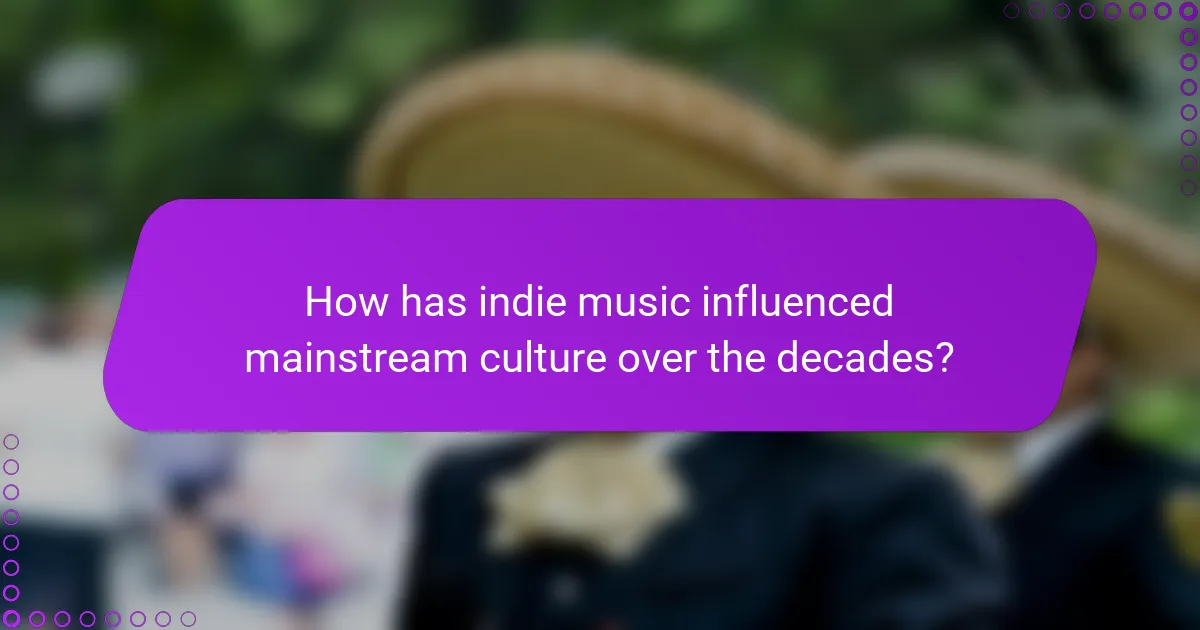
How has indie music influenced mainstream culture over the decades?
Indie music has significantly shaped mainstream culture by introducing diverse sounds and promoting artistic authenticity. Over the decades, indie artists have influenced fashion, film, and social movements, leading to a broader acceptance of alternative styles in popular media.
In the 1980s, bands like R.E.M. and The Smiths brought alternative sounds to a wider audience, paving the way for grunge in the 1990s with acts such as Nirvana. This era showcased a shift where independent labels became pivotal in discovering and nurturing talent, impacting mainstream music trends.
The 2000s saw the rise of digital platforms, allowing indie artists to reach global audiences without major label support. This democratization of music led to the emergence of genres like indie pop and folk, influencing mainstream artists to experiment with their sounds.
Today, indie music continues to impact mainstream culture by challenging norms and encouraging diversity in music production. Artists like Billie Eilish and Tame Impala blend indie aesthetics with mainstream appeal, demonstrating the ongoing influence of indie music on the broader cultural landscape.
What role did indie music play in the 1990s alternative scene?
Indie music was pivotal in the 1990s alternative scene, driving cultural change and musical diversity. It fostered a sense of authenticity and independence, contrasting mainstream pop. Key milestones include the rise of labels like Sub Pop and the emergence of influential bands such as Nirvana and Radiohead. These entities shaped the sound and ethos of the era, emphasizing raw emotion and innovative production. The DIY approach allowed artists to connect directly with audiences, creating a lasting legacy that continues to influence music today.
Which artists emerged from the indie music movement in the early 2000s?
Notable artists from the early 2000s indie music movement include The Strokes, Arcade Fire, Death Cab for Cutie, and Yeah Yeah Yeahs. These bands played a crucial role in shaping the genre’s sound and expanding its mainstream appeal. The Strokes, with their debut album “Is This It,” defined a new wave of garage rock revival. Arcade Fire’s “Funeral” brought orchestral elements to indie rock, while Death Cab for Cutie’s emotional lyrics resonated widely. Yeah Yeah Yeahs combined punk energy with art rock aesthetics, contributing to the movement’s diversity.

What are the defining characteristics of indie music today?
Indie music today is characterized by its diverse sounds, DIY ethos, and blending of genres. The genre has evolved, incorporating influences from pop, electronic, and hip-hop, reflecting broader cultural trends. Unique attributes include a focus on authenticity and independent production, allowing artists to maintain creative control. Rarely, indie music collaborates with mainstream artists, creating crossover hits that challenge traditional boundaries.
How do independent labels operate compared to major labels?
Independent labels operate with greater artistic freedom and flexibility compared to major labels. They often prioritize niche markets and foster close relationships with their artists. Major labels typically focus on mass-market appeal, utilizing extensive marketing resources and industry connections.
Independent labels emphasize creative control, allowing artists to explore diverse sounds and concepts. They often rely on grassroots marketing and direct fan engagement, which can lead to a loyal following. In contrast, major labels leverage their financial power to promote artists through mainstream media channels.
The evolution of indie music has seen significant milestones, such as the rise of digital distribution and social media, which have empowered independent artists. Looking ahead, indie labels are likely to continue adapting to technological advancements and shifting consumer preferences.
Which genres are most commonly associated with indie music?
Indie music is commonly associated with genres such as alternative rock, folk, electronic, and indie pop. These genres reflect the diverse influences and experimental nature of indie music. Alternative rock emerged in the 1980s, characterized by its independent production and unique sound. Folk elements often infuse storytelling and acoustic instrumentation, while electronic influences introduce innovative production techniques. Indie pop tends to focus on catchy melodies and introspective lyrics, showcasing the genre’s eclectic nature.
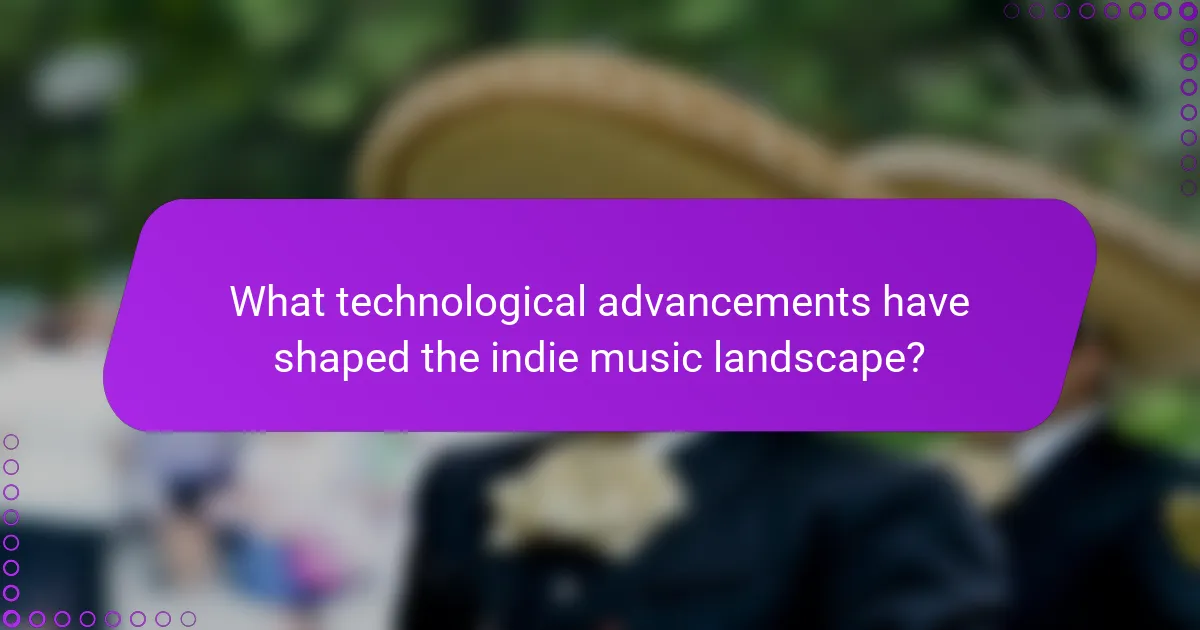
What technological advancements have shaped the indie music landscape?
Technological advancements have significantly influenced the indie music landscape by enhancing distribution, production, and promotion. Digital platforms like Bandcamp and SoundCloud empower independent artists to reach audiences directly. Home recording software democratizes music production, allowing high-quality recordings without major label support. Social media enables targeted marketing and fan engagement, fostering communities around indie music. Streaming services have reshaped revenue models, emphasizing the importance of playlist placements. These innovations create opportunities for diverse voices in the music industry.
How has streaming transformed indie music distribution?
Streaming has revolutionized indie music distribution by providing artists direct access to global audiences. This shift eliminates traditional gatekeepers like record labels, allowing for greater creative freedom. Platforms like Spotify and Bandcamp enable musicians to share their work instantly, fostering diverse sounds and styles. Additionally, streaming analytics empower artists to understand their audience better and tailor their marketing strategies effectively. As a result, indie music has gained significant visibility and traction in the mainstream market, paving the way for future innovations in music distribution.
What impact has social media had on indie artist promotion?
Social media has significantly transformed indie artist promotion by enhancing visibility and engagement. Platforms like Instagram and TikTok allow artists to connect directly with fans, bypassing traditional gatekeepers. This democratization fosters diverse musical expressions and grassroots movements. Unique attributes, such as viral challenges, can propel an indie track to mainstream success. As a result, social media has become essential for indie artists to build their brand and reach wider audiences.
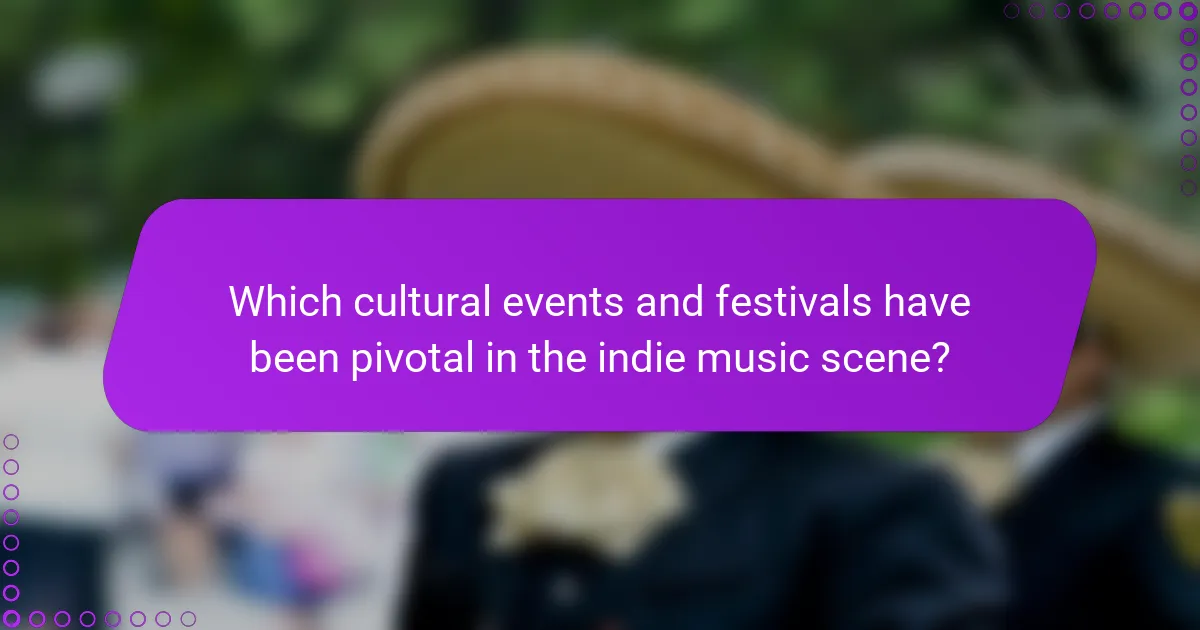
Which cultural events and festivals have been pivotal in the indie music scene?
Cultural events and festivals have significantly shaped the indie music scene by providing platforms for emerging artists. Notable events include South by Southwest (SXSW), which showcases diverse musical talent, and Coachella, known for its eclectic lineups. Other pivotal festivals are Primavera Sound, which emphasizes international acts, and Pitchfork Music Festival, focusing on indie and alternative genres. These events foster community, creativity, and innovation, propelling indie music into mainstream consciousness.
What is the significance of South by Southwest (SXSW) for indie artists?
South by Southwest (SXSW) is crucial for indie artists as it offers exposure, networking, and opportunities for growth. The festival serves as a platform where emerging talent can showcase their music to industry professionals and a diverse audience. Indie artists often gain significant visibility, leading to potential collaborations and record deals. Additionally, SXSW’s emphasis on innovation aligns with the evolving landscape of indie music, encouraging artists to experiment and connect with fans. The event’s historical significance includes fostering key milestones in indie music, reinforcing its role in shaping future directions.
How do regional festivals differ in their support for indie music?
Regional festivals differ in their support for indie music based on their cultural focus, funding sources, and audience engagement strategies. Festivals in urban areas often provide more resources, attracting diverse indie acts, while rural festivals may emphasize local talent and community involvement. Regional differences can also influence the types of genres showcased, with some festivals prioritizing specific styles that resonate with local audiences. Furthermore, initiatives like artist residencies and workshops vary, impacting how indie musicians gain exposure and support.

What challenges do indie musicians face in the current market?
Indie musicians face numerous challenges in the current market, including financial instability, limited access to distribution channels, and intense competition. The rise of digital platforms has democratized music distribution but has also saturated the market, making visibility a significant hurdle. Additionally, many indie artists struggle with marketing and promotion due to insufficient budgets and resources. The evolving landscape demands adaptability, as trends shift rapidly, requiring musicians to constantly innovate and engage with audiences.
How does funding affect indie music production and promotion?
Funding significantly influences indie music production and promotion by enabling artists to access resources and reach wider audiences. Financial support allows for better recording quality, marketing strategies, and distribution channels. Historically, indie musicians relied on personal funds or small labels, limiting their reach. Today, crowdfunding and digital platforms provide new avenues for funding, enhancing visibility and engagement. This evolution reflects a unique attribute of indie music, where community support directly impacts artistic expression and success. As a result, the future of indie music relies heavily on innovative funding solutions to adapt to changing market dynamics.
What are the common pitfalls for emerging indie artists?
Emerging indie artists often face pitfalls that hinder their growth. Common challenges include lack of marketing knowledge, insufficient funding, and inadequate networking. Many artists underestimate the importance of building a brand and engaging with their audience. Additionally, navigating digital platforms can be overwhelming, leading to missed opportunities. Lastly, some artists struggle with maintaining creative control while seeking commercial viability.
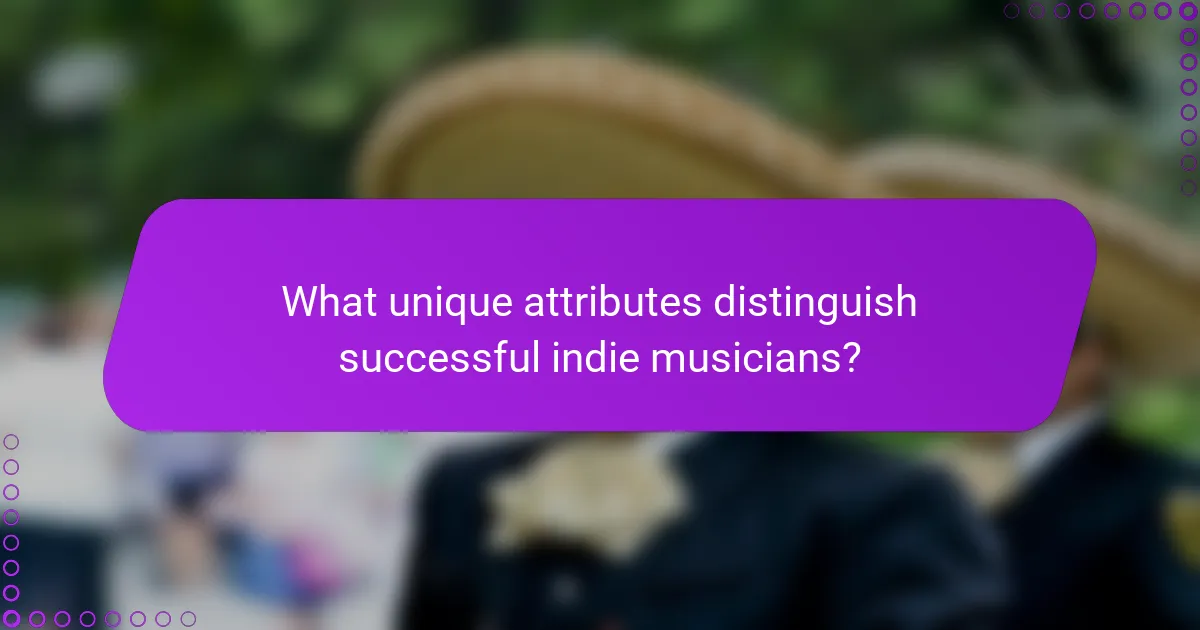
What unique attributes distinguish successful indie musicians?
Successful indie musicians are distinguished by their unique artistic vision, strong community engagement, and innovative marketing strategies. These attributes allow them to carve out distinct identities in a competitive music landscape.
The ability to connect authentically with their audience sets them apart. They often leverage social media platforms to build loyal fanbases and share personal stories. This direct engagement fosters a sense of community and belonging among listeners.
Creativity in music production and genre-blending is another unique attribute. Indie musicians frequently experiment with sounds, leading to fresh and diverse musical offerings that resonate with various audiences.
Lastly, resourcefulness in navigating the music industry is vital. Successful indie musicians often manage their own branding, distribution, and promotion, allowing for greater control over their careers and artistic output.
Which indie artists have achieved international acclaim?
Several indie artists have achieved international acclaim, including Bon Iver, Sufjan Stevens, and Florence + The Machine. Bon Iver gained recognition for its unique sound blending folk and electronic elements, winning multiple Grammy Awards. Sufjan Stevens is celebrated for his intricate storytelling and diverse musical styles, while Florence + The Machine’s powerful vocals and dramatic performances have captivated audiences worldwide. These artists exemplify the global reach and influence of indie music today.
How do personal narratives influence indie music songwriting?
Personal narratives significantly shape indie music songwriting by providing authentic emotional depth. Artists often draw from personal experiences, allowing listeners to connect on a profound level. This approach fosters a unique storytelling style, distinguishing indie music from mainstream genres. The raw honesty in lyrics often reflects themes of identity, struggle, and personal growth, resonating with audiences seeking relatable content. As a result, personal narratives enhance the overall impact and relevance of indie music, driving its evolution and appeal.
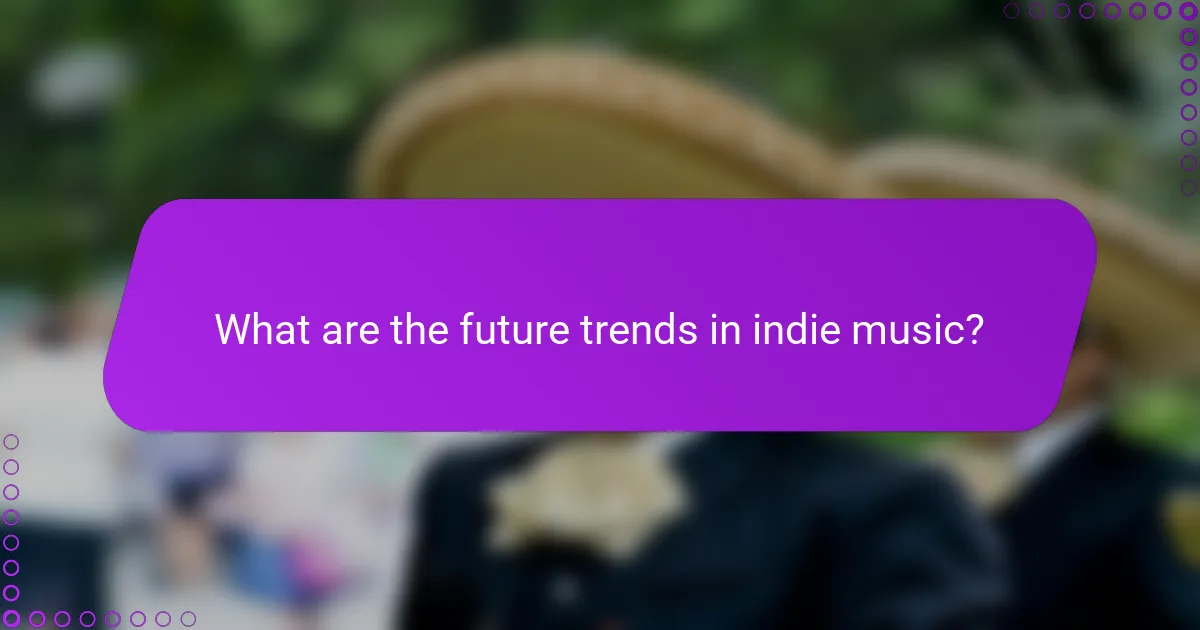
What are the future trends in indie music?
Future trends in indie music include increased digital distribution, genre blending, and a focus on sustainability. Artists will leverage technology for direct fan engagement and explore innovative soundscapes. Collaborations across diverse genres will become more common, enhancing the creative landscape. Additionally, the rise of social media platforms will continue to shape how indie artists market their music and connect with audiences.
How is the rise of virtual concerts changing the indie music experience?
Virtual concerts are transforming the indie music experience by expanding access and engagement. Artists can reach global audiences without geographical limitations. This shift allows for diverse collaborations and innovative performances. Additionally, virtual platforms often reduce production costs, enabling indie musicians to invest more in their craft. As technology evolves, the integration of immersive experiences, such as virtual reality, promises to further enhance audience interaction and connection with indie artists.
What role will artificial intelligence play in music creation and distribution?
Artificial intelligence will significantly enhance music creation and distribution. AI tools can analyze trends, generate melodies, and assist in mastering tracks, making music production more accessible. Additionally, AI algorithms can optimize distribution by analyzing listener preferences, ensuring targeted marketing. This evolution will democratize music-making, allowing indie artists to reach wider audiences efficiently.
What strategies can indie musicians adopt for sustainable success?
Indie musicians can adopt several strategies for sustainable success by focusing on community engagement, diverse revenue streams, and digital presence. Building a loyal fanbase through social media and live performances enhances visibility. Diversifying income through merchandise, crowdfunding, and licensing opportunities creates financial stability. Investing in digital marketing and data analytics helps in understanding audience preferences, guiding future projects. Collaborations with other artists can expand reach and foster creativity, ensuring long-term relevance in the evolving music landscape.
